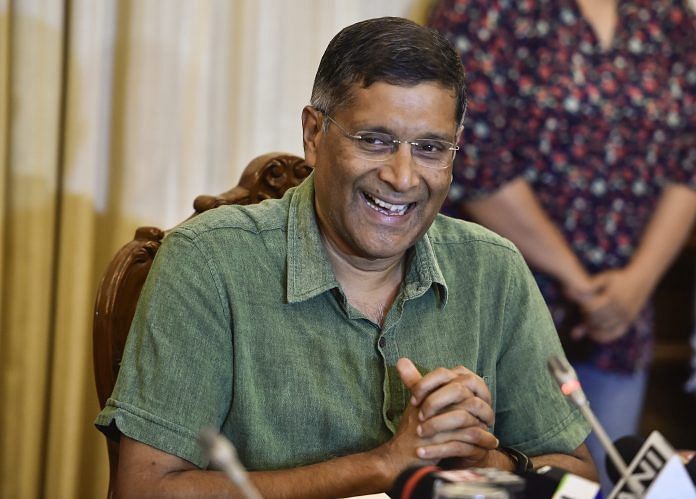New Delhi: Former chief economic adviser Arvind Subramanian has hit back at critics who had slammed him for his study last month that said India’s growth may have been overestimated by 2.5 percentage points every year between fiscal 2012 and 2017.
Countering criticism that he spoke up only after leaving the government, Subramanian said in a new working paper published Thursday that his concerns were flagged in his economic survey of 2015 and in the ones in the subsequent years.
“Thus, all the issues that I raised in my recent paper—the inconsistency between GDP growth and other macro-indicators, the puzzling divergence in manufacturing estimates, the need for caution in using the GDP estimates—were flagged by my team and I almost immediately after the new estimates were released,” Subramanian wrote in his latest paper titled ‘Validating India’s GDP Growth Estimates’.
In the paper, Subramanian says no country has been able to achieve a 7 per cent growth over a five-year period with an investment and export growth of as low as 3 per cent as seen by India, defending his earlier findings that the Indian economy’s growth may have been overestimated by 2.5 percentage points.
The paper also said that no emerging market economy has managed to sustain high GDP growth rates with large macroeconomic shocks contrary to the growth seen in India.
Subramanian’s June paper had pointed out that India may have only grown at an average of 4.5 per cent in the period 2011-12 and 2016-17.
Using various real sector indicators such as exports, credit growth, freight rates and factory output, Subramanian had pointed out that these indicators declined significantly post-2011 but the GDP growth rate was hardly affected.
Subramanian’s use of real indicators to measure GDP has come under severe criticism from various quarters including the Prime Minister’s economic advisory council. Subramanian’s new paper seeks to counter some of these criticisms point by point.
Series of shocks didn’t hurt growth?
The new paper pointed out that in the 2011-16 period, India was hit by a series of macroeconomic shocks like export collapse, twin balance sheet problem, oil prices and terms of trade, drought, demonetisation and loss of macroeconomic stability under UPA-2 in 2012-13.
These shocks impacted key macro-demand indicators as reflected in contraction of real credit to industry to -1 per cent from 16 per cent, decline in real investment rate to 3 per cent from 13 per cent, falling export growth to 3 per cent from 13 per cent and imports from 17 per cent to -1 per cent, the paper pointed out, questioning how despite all these large shocks, “economic growth declined by very little, slipping from 7.7 per cent to 6.9 per cent”.
The paper also highlighted the large difference between formal manufacturing growth as recorded in the national accounts and in the index of industrial production and a large wedge between the GDP deflator and CPI post-2011 to reinforce the case that real GDP growth is over-estimated.
Both GDP deflator and CPI are measures of inflation, and GDP deflator is used as a divisor to estimate real GDP from its nominal counterpart.
Subramanian also pointed out that some of the criticism of the 4.5 per cent growth number could be on account of the fact that it reflects the ‘Hindu rate of growth’ seen in the pre 1980s era. He writes that the two rates are not comparable as the current growth rate translates into a much higher per capita growth as compared to the earlier time period.
Also read: Modi’s suspect GDP numbers have done real damage to India’s economy




If the world loses faith in the reliability of official statistics and data, that is bound to affect its willingness to invest in the country. Dr A S is using common sense indicators to gauge the health of the economy. His conclusions should be countered with facts and figures, not emotion and polemic.